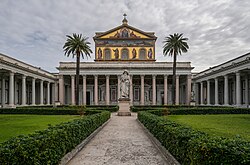
The following is a list of Basilicas in Rome. An ecclesiastical basilica is a Roman Catholic church building which has been granted special status by the Pope. There are 66 such churches in Rome, more than any other city, [Note 1] and more than 125 of the 131 countries in the world that have basilicas. [Note 2]




